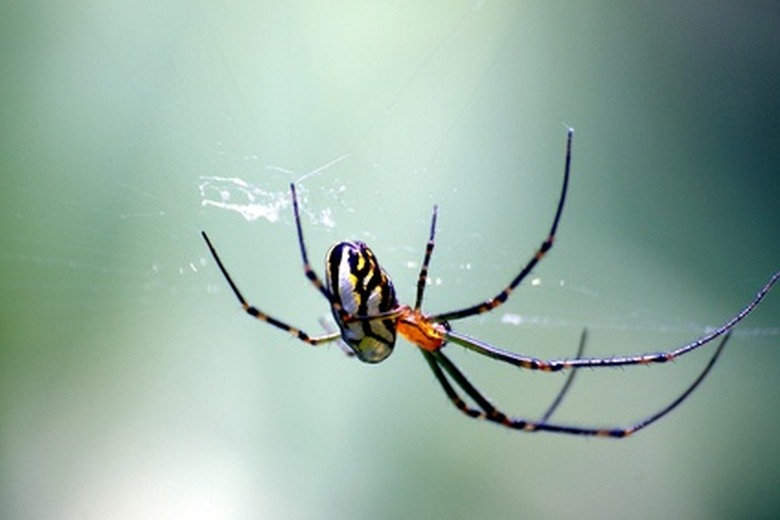Poisonous Spiders In Madagascar
Madagascar is an island nation off the coast of Mozambique.. The mainland of Madagascar is the fifth largest island in the world. A wide diversity of animals are scattered across the mainland and the 250 smaller surrounding islands. Madagascar features many habitats including lush tropical rain forests, dry forests, deserts and beaches. It also has spiders, but not many of these are poisonous.
Island Dynamics
Island Dynamics
The isolating nature of oceanic islands means they often evolve unique plants and animals. Animals on oceanic islands can't move from place to place with the same ease that animals living on vast continents can. The limited space forces organisms to adapt to their surroundings. Big animals may become smaller, small animals may become larger and animals may change their behaviors as they evolve to suit the available resources.
Madagascar's Endemic Animals
Madagascar's Endemic Animals
Madagascar is home to unusual mammals such as the aye-aye, numerous species of lemurs, birds, reptiles, amphibians and insects. Approximately 75 percent of the animals found in Madagascar are endemic, which means that they aren't found anywhere else in the world. The high rate of endemism in Madagascar means that species are particularly vulnerable to extinction due to habitat loss.
Dangerous Animals in Madagascar
Dangerous Animals in Madagascar
For a large island, Madagascar has very few animals considered dangerous to humans. The exceptions are Nile crocodiles, some scorpions, snakes, spiders and hissing cockroaches. In Madagascar, poisonous snakes can be found on land and in the ocean. However, poisonous snakes in Madagascar are rear-fanged or found in the sea, so they pose little risk to humans walking around the forest.
Poisonous Madagascar Spiders
Poisonous Madagascar Spiders
There are few poisonous spiders out of the 400 recorded spider species on Madagascar. Poisonous spiders include the pelican spider, Madagascan black widow spider and brown widow spider. The island is also home to potentially dangerous tarantulas that can shoot hairs from their back when they are threatened, causing irritation of skin and lungs if inhaled.
Madagascan Black Widow Spider
Madagascan Black Widow Spider
Black widow spiders are found around the globe, including a variant in Madagascar known as Latrodectus menavodi. Their bodies are a pitch black color. The bright red triangle on the base of their abdomen identifies black widow spiders. The Madagascan black widow spider has a unique venom blend that contains a compound called 2,4,6-trihydroxypurine that has not been found in spider venom before. Bites from this spider can be fatal to humans.
Brown Widow Spider
Brown Widow Spider
The brown widow spider, Latrodectus geometricus, is considered an invasive species around the globe. They tend to live in buildings, old tires and under objects like cars. Brown widow spiders are not aggressive, but their venom is twice as potent as black widow spiders. The markings on their abdomens can be dark-brown, black, white, yellow or orange. They have a unique orange hourglass marking on their underside.
Pelican Spider
Pelican Spider
The unusual looking pelican spiders, otherwise known as assassin spiders, are in the Archaeidae family. They are found worldwide; however, there are several species of assassin spiders endemic to Madagascar in the Madagascarchaea genus. The name pelican comes from their unusually elongated carapace and chelicerae, making them look as if they have a long neck and beak, like a pelican. The name assassin comes from their stealthy night hunting skills where they capture their prey and then inject them with their deadly venom.
The pelican spider doesn't spin webs. Instead, it captures prey by impaling them with their long chelicerae, injecting their venom, and then waiting for their victim to die. Interestingly, they recognize individuals from their species, and when placed together in a container, they will spread out to give each other space and never attack. While the venom from these spiders is deadly to their prey, they pose little danger to humans due to their tiny size.
References
- The University of Adelaide: Clinical Toxinology Resources: Latrodectus Obscurior
- Toxicon: The Main Products of the Low Molecular Mass Fraction in the Venom of the Spider Latrodectus Menavodi
- Wild Madagascar: The Real Animals of Madagascar
- Science Nordic: Islands Make Large Animals Shrink and Small Animals Grow
- WWF: Madagascar
- Wild Madagascar: Snakes of Madagascar
- Mada Magazine: Insects and Arachnids in General
- Encyclopaedia Britannica: 9 of the World's Deadliest Spiders
- Medecine Tropicale: Latrodectism in Madagascar
- Zoo Keys: A Review of the Madagascan Pelican Spiders of the Enera Eriauchenius O. Pickard-Cambridge, 1881 and Madagascarchaea Gen. N. (Araneae, Archaeidae)
- National Geographic: 18 Spider-Killing Spiders Discovered and They Look Like Pelicans
Cite This Article
MLA
Jerrett, Adrianne. "Poisonous Spiders In Madagascar" sciencing.com, https://www.sciencing.com/poisonous-spiders-madagascar-6157062/. 22 November 2019.
APA
Jerrett, Adrianne. (2019, November 22). Poisonous Spiders In Madagascar. sciencing.com. Retrieved from https://www.sciencing.com/poisonous-spiders-madagascar-6157062/
Chicago
Jerrett, Adrianne. Poisonous Spiders In Madagascar last modified March 24, 2022. https://www.sciencing.com/poisonous-spiders-madagascar-6157062/
